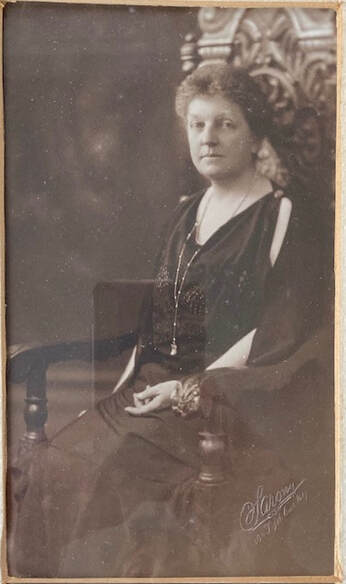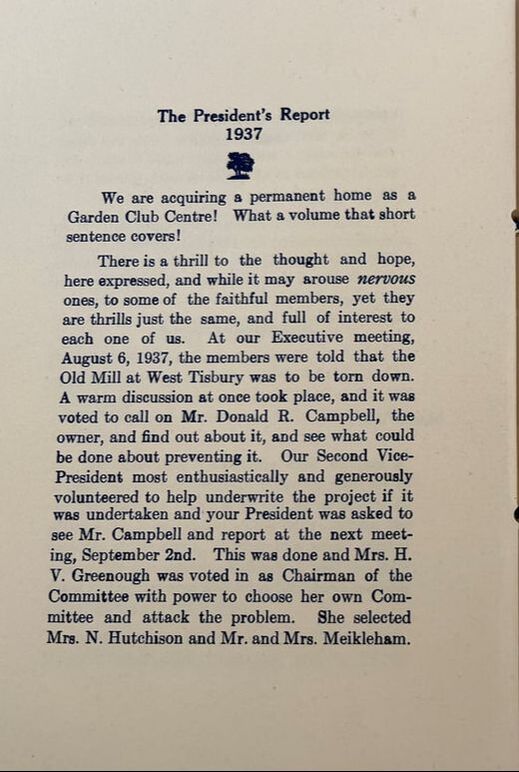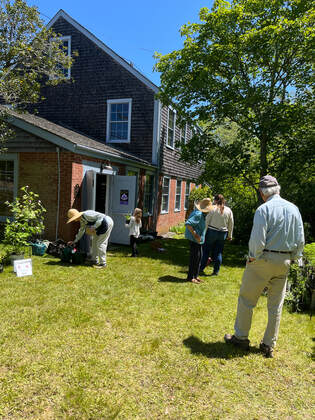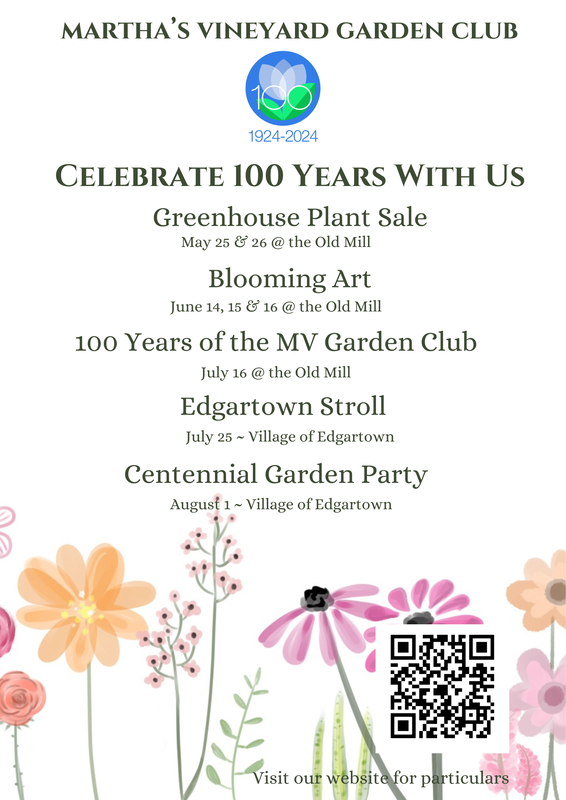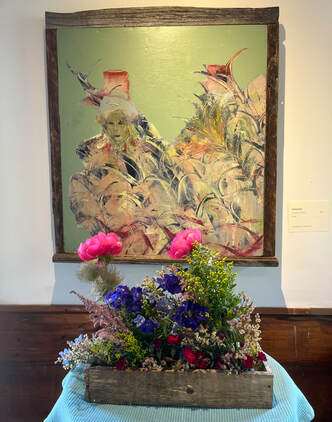The MV Garden Club's Centennial Year
Martha's Vineyard Museum Exhibit - May 23 - September 20, 2024!
What a feeling of pride and a beautiful 'Opening Night' it was!
On May 22, 2024, the Martha's Vineyard Garden Club was invited to preview the exhibit
at the MV Museum, honoring the many contributions of the MV Garden Club to the Island, over the past 100 years.
Do visit the MV Museum and see it in person if you can...the exhibit runs until September 20, 2024!
What a feeling of pride and a beautiful 'Opening Night' it was!
On May 22, 2024, the Martha's Vineyard Garden Club was invited to preview the exhibit
at the MV Museum, honoring the many contributions of the MV Garden Club to the Island, over the past 100 years.
Do visit the MV Museum and see it in person if you can...the exhibit runs until September 20, 2024!
CLICK HERE to read a story about our inspirational founder, Mrs. Agnes D. Meikleham, told so beautifully by MVGC member, Jane Bradbury. This piece was in the June 27, 2024 edition of the Vineyard Gazette. Our sincere thanks to the Gazettte for sharing this with their readers!
CLICK HERE to read 'A blooming century', an article which appeared in the MV Times news in early June. This story highlights a bit of the Club's history and lists our upcoming celebratory events and programs through the Summer. Our sincere thanks to the Times for sharing this with their readers!
Visit our website home page to join us for our upcoming meetings,
The Edgartown Stroll, 2024 and A Centennial Garden Party!
All details and particulars are posted there!
The Edgartown Stroll, 2024 and A Centennial Garden Party!
All details and particulars are posted there!
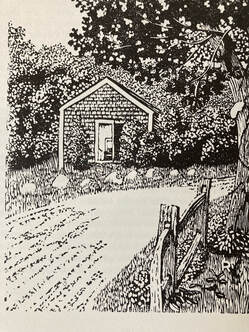
The Martha's Vineyard Garden Club helped save historic Christiantown site!
The Christiantown Indian burial ground in West Tisbury is one of the oldest historic sites on the island. In 1659 a one mile square of land was “given” to the praying Indians. Under the efforts of Thomas Mayhew, Jr., a small chapel was erected. No one knows how old the burial ground there really is, for Indians occupied this territory long before the white man came, and may have buried their dead there for hundreds of generations before. But the graves marked with the small, rounded stones are easily identifiable as those of the Praying Indians.
In 1941 The Dukes County commission ordered the complete restoration of the decaying chape', the road leading to it to be put into usable condition, and the burial ground sufficiently cleared so that the graves become accessible and to continuing proper care. At that time, the Garden Club offered the commissioners its services in cleaning up and beautifying the area.
In 1946, the Garden Club's efforts increased to include the protection of the site from a proposed fire watch tower, which would have to run a power line directly through the burial ground. Thankfully they were successful and the fire tower was relocated.
In 1947 our club began its planting around the area of wildflowers and shrubs indigenous to the Vineyard: mayapple, violets, Solomon's Seal, loosestrife, and swamp azalea to name a few. A standing committee existed for decades thereafter to continue the maintenance of this exceptional and treasured piece of Martha's Vineyard history. Our stewardship ended in 1993. - From Ty Johnston
The Christiantown Indian burial ground in West Tisbury is one of the oldest historic sites on the island. In 1659 a one mile square of land was “given” to the praying Indians. Under the efforts of Thomas Mayhew, Jr., a small chapel was erected. No one knows how old the burial ground there really is, for Indians occupied this territory long before the white man came, and may have buried their dead there for hundreds of generations before. But the graves marked with the small, rounded stones are easily identifiable as those of the Praying Indians.
In 1941 The Dukes County commission ordered the complete restoration of the decaying chape', the road leading to it to be put into usable condition, and the burial ground sufficiently cleared so that the graves become accessible and to continuing proper care. At that time, the Garden Club offered the commissioners its services in cleaning up and beautifying the area.
In 1946, the Garden Club's efforts increased to include the protection of the site from a proposed fire watch tower, which would have to run a power line directly through the burial ground. Thankfully they were successful and the fire tower was relocated.
In 1947 our club began its planting around the area of wildflowers and shrubs indigenous to the Vineyard: mayapple, violets, Solomon's Seal, loosestrife, and swamp azalea to name a few. A standing committee existed for decades thereafter to continue the maintenance of this exceptional and treasured piece of Martha's Vineyard history. Our stewardship ended in 1993. - From Ty Johnston
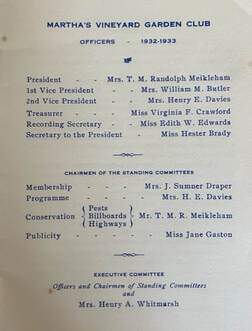
In honor of our upcoming centennial celebration, here is a small excerpt from an editorial written on the occasion of our 40th anniversary in 1964...This editorial was in the Gazette on August 14, 1964!
“The fortieth anniversary of the Martha's Vineyard Garden Club this summer may well remind lovers of the island that despite a widespread antipathy for the word, the island has benefited by a considerable degree of planning. This, of course, has been the result of the wise concern of the Garden Club and its early leaders with protection of the Vineyard's natural resources and an enlightened oversight of exploiting influences.
“There is a distinct Garden Club tradition with an element of militancy that has ….. come to be respected and valued. It would be hard to find anyone on the Island who is not proud of the freedom of the roadsides from billboards and defacing structures, and of the native hedgerows attractively clipped instead of hacked and deformed. This pride has been enhanced, year after year, by the admiring astonishment of visitors who look upon these conserved values as miraculous.”
“The fortieth anniversary of the Martha's Vineyard Garden Club this summer may well remind lovers of the island that despite a widespread antipathy for the word, the island has benefited by a considerable degree of planning. This, of course, has been the result of the wise concern of the Garden Club and its early leaders with protection of the Vineyard's natural resources and an enlightened oversight of exploiting influences.
“There is a distinct Garden Club tradition with an element of militancy that has ….. come to be respected and valued. It would be hard to find anyone on the Island who is not proud of the freedom of the roadsides from billboards and defacing structures, and of the native hedgerows attractively clipped instead of hacked and deformed. This pride has been enhanced, year after year, by the admiring astonishment of visitors who look upon these conserved values as miraculous.”
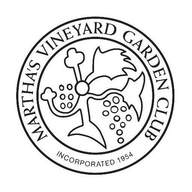
The MV Garden Club's Seale -
Our seale is the ancient official seal of the county of Dukes County, adopted a few years after the settlement of Martha’s Vineyard. Edgartown records of 1655 state, “the common seale of this place shall be a bunch of grapes.”
The earliest representation of the seal is found in early manuscript papers kept by the Congressional Library. Certain of these papers have been designated as “Athern Mss.” Because they are original drafts of legal documents prepared by Kames and Jabez Athern in their official capacities as Justices of the Peace and Clerk of the Courts on Martha’s Vineyard. The representation of the seal in the Athern manuscripts of 1722 looks exactly like our logo! We are very fortunate to have a seal with such a ling Island history. It could have gone to many other groups but it is
our good fortune to have secured it for ourselves.
Our seale is the ancient official seal of the county of Dukes County, adopted a few years after the settlement of Martha’s Vineyard. Edgartown records of 1655 state, “the common seale of this place shall be a bunch of grapes.”
The earliest representation of the seal is found in early manuscript papers kept by the Congressional Library. Certain of these papers have been designated as “Athern Mss.” Because they are original drafts of legal documents prepared by Kames and Jabez Athern in their official capacities as Justices of the Peace and Clerk of the Courts on Martha’s Vineyard. The representation of the seal in the Athern manuscripts of 1722 looks exactly like our logo! We are very fortunate to have a seal with such a ling Island history. It could have gone to many other groups but it is
our good fortune to have secured it for ourselves.

Read about our contributions to the Island and the Club's
history thanks to the MV Times!
We want to extend huge thanks to the Martha's Vineyard Times for sharing the story of our history in the newspaper and online. As the Island's first conservation organization, read about the impact our Club has had on the Island and our dedication in carrying on the vision of those who came before us.
CLICK HERE to read the online article put out by the MV Times in February, 2024.
We are grateful for the support and by spreading the word about our Club in this special year!














